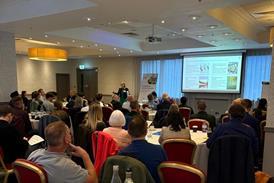All Guidance Document articles
-
 REACHReady Guide
REACHReady GuideREACH, CLP and BIOCIDE Glossary
You can download these definitions but please note that they are for information purposes only. The legal texts are the only authentic legal references; please see the relevant legislation for the full and exact legal definitions.
-
 REACHReady Guide
REACHReady GuideWhat Does CLP Mean for Retailers?
Introduction Any retailer who sells paint, nail varnish remover, bleach or washing powder will have seen the orange and black warning symbols which adorn the packaging of these chemically based products. The main responsibility for deciding what label goes on these products is the job of the manufacturer or ...
-
 REACH bespoke training
REACH bespoke trainingManaging REACH: Communication is key
Ideal training for Dwonstream Users. If you use a chemical substance, either on its own or in a preparation, in the course of your business activities you are a downstream user under EU/GB REACH.
-
 REACH bespoke training
REACH bespoke trainingWriting your Chemical Safety Report
Anyone that is involved in REACH and registering a substance in a tonnage band greater than 10 tonnes per year or an SVHC, will need to write a chemical safety report (CSR) to support their registration.
-
 REACH bespoke training
REACH bespoke trainingUK and EU REACH Registration: Inquiry and the Next Steps
This workshop will be of particular interest to companies that need to register before manufacture or import of substance(s).
-
 REACH bespoke training
REACH bespoke trainingImporting goods into the EU/UK, managing your SVHC obligations
Every product is made from substances, and substances in articles need to be “registered” if they are intended to be released.
-
 REACHReady Guide
REACHReady GuidePPORD Dossier Creation
The PPORD exemption allows manufacture or import of 1 tonne or more per year of a substance for production and process oriented research and development by yourself or customers without full registration. Only if the trials are successful and there is a need for commercial production or use, will a full registration be needed.
-
 REACHReady Guide
REACHReady GuideTransitional Measures under the BPR
On 1 September 2013, the European Commission implemented the Biocidal Products Regulation (BPR), in doing so repealing the Biocidal Products Directive (BPD) and the Member States’ national legislation implementing it.
-
 REACHReady Guide
REACHReady GuideREACHReady Membership Terms and Conditions
PLEASE TAKE THE TIME TO READ THESE TERMS AND CONDITIONS. They will apply to all persons who subscribe to any REACHReady Gold service through the REACHReady website, email, post, or by phone and will supersede any previous terms and conditions.
-
 REACHReady Guide
REACHReady GuideArticle 26 Inquiries - GB and EU REACH
Although those used to the REACH Registration process will be familiar with the use of IUCLID software and the procedures to follow, UK based companies who have been able to rely on DUINs or who need to import into the UK for the first time, or who are helping EU customers with EU REACH to allow export, may be facing the need for Registration for the first time.
-
 REACHReady Guide
REACHReady GuideAn introduction to Article 26 Inquiry
The aim of REACH is to improve the protection of human health and the environment. In order to understand the risks of chemicals and know how to use them safely, the intrinsic hazardous properties of those substances must first be identified.
-
 REACHReady Guide
REACHReady GuideSocio-economic analysis and REACH
The overall aim of a socio-economica analysis is to analyse and document whether the socio-economic benefits of continued use of a substance outweigh the risks of continued use for human health and the environment.
-
 REACHReady Guide
REACHReady GuideApplying for an Authorisation
If you supply products containing Substances of Very High Concern (SVHCs) on the Candidate List, you and your customers are likely to be concerned about future supply and what might happen if that substance becomes subject to Authorisation under REACH. This concise guidance document explains what Authorisation means, how it might affect you and what you need to do.
-
 REACHReady Guide
REACHReady GuideDeciding whether to apply for authorisation
Seeking authorisation will be a time-consuming and expensive process, and there are no guarantees that an application will be successful. Our guidance will show you what to do.
-
 REACHReady Guide
REACHReady GuideWhat to do when a substance appears on the Authorisation List
This short document explains briefly how Authorisation might affect you if you supply products containing substances that end up in Annex XIV to REACH and which actions you may need to take, depending on your role in the supply chain.
-
 REACHReady Guide
REACHReady GuideREACHReady template letters
Many of our subscribers have asked us to draft letters they can send to their contacts addressing the key questions about responsibilities under REACH and CLP.
-
 REACHReady Guide
REACHReady GuideCommunication of uses
One key aspect of REACH is to improve communication in the supply chain. An increased amount of available information will ensure Downstream Users (DUs) of substances and mixtures have some assurance that how they use those chemicals is appropriate. It will also ensure that suppliers of chemicals do not propose uses that are not fit for purpose.
-
 REACHReady Guide
REACHReady GuideUnderstanding the Safety Data Sheet Changes
Safety data sheets (SDS) have been around for a long time and they serve as a key communication tool for supply chains. Suppliers provide SDS to industrial and professional users to ensure they have accurate information on hazards, risks and their management; recipients of the SDS use the information to ensure safe use on site, and to prepare their own SDS for any onward supply of chemicals.
-
 REACHReady Guide
REACHReady GuideCommunication in the supply chain
REACH is complicated enough without customers and suppliers asking questions that are irrelevant, incorrect or unnecessary. This extra administrative work can waste time for everyone, especially as suppliers do not want to appear uncooperative towards their customers.
-
 REACHReady Guide
REACHReady GuideBrexit: Preparing for a future «UK out of REACH scenario»
What you need to know - Practical considerations to maintain trade post Brexit






